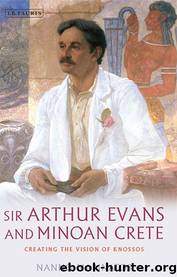Sir Arthur Evans and Minoan Crete by Marinatos Nanno

Author:Marinatos, Nanno
Language: eng
Format: epub
ISBN: 9780857738837
Publisher: I.B. Tauris
The Excavation of the Temple Tomb
A year went by. In the meantime, the Ring of Minos made its appearance, and Evans was motivated to locate its source, searching the environs of the Palace for the alleged find-spot of this spectacular gem. The result was unexpected since he found not one but two important buildings. The first was surnamed House of the High Priest (because of its evident similarities to a Christian chapel) whereas the second was baptized the Royal Temple Tomb because it included a tomb as well as a shrine. On this latter building the subsequent discussion will focus because of the direct involvement of Marinatos (see Figure 31).
First, there can be no doubt about the fact that the building was close to the alleged find-spot of the Minos ring and this is why Evans considered its discovery proof that the ring was genuine. The gem, he said, had accidentally escaped the Minoan robbers of the Temple Tomb and had rested in the soil for more than 1,000 years! Marinatos did not believe this and had a different interpretation of why the building was found.19 He knew that Evans had a trusted man whom he had personally trained to survey the soil for ruins. This man was named Manolis or Manolakis Akoumianakis and was also his foreman at Knossos (Figure 32). It was this Manolis who noticed unusual slabs on the surface of the soil near the Palace and told Evans about them. The latter understood that a building was concealed there and began excavations immediately. Marinatos did not find it so remarkable or unexpected that a large building was situated close to the Palace, and its existence did not prove in his eyes the authenticity of the Ring of Minos. Evans thought otherwise, however, and regarded this new discovery as miraculous.20
A more important issue on which Evans and Marinatos agreed was the function of the new spectacular two-storey building. Was it indeed a tomb? Contemporary scholars have disputed this fact on the grounds that no skeleton was found in the so-called burial chamber, and they intimate that Evans found only what he wished.21 And yet there is incontrovertible evidence that the building was indeed a combination of grave and sanctuary since John Pendlebury reports a disarticulated skeleton of a man of middle age from the entrance of the burial chamber.22 It was dedicated simultaneously to the royal cult and the chief divinity of the Minoans.
Built in ashlar masonry, the Temple Tomb was fronted by a solid gate reminiscent of Egyptian tombs. Passing the gate, the visitor would enter an interior court that passed to a vestibule; a stairway led to the upper storey. The vestibule led to a pillar crypt of the type well known from the Palace and the Royal Villa (Figure 33a–b). It contained two pillars and ashlar blocks marked with double axes, recalling not just similar Pillar Crypts but the Tomb of the Double Axes as well.23 An added feature was that the door of
Download
This site does not store any files on its server. We only index and link to content provided by other sites. Please contact the content providers to delete copyright contents if any and email us, we'll remove relevant links or contents immediately.
| Africa | Americas |
| Arctic & Antarctica | Asia |
| Australia & Oceania | Europe |
| Middle East | Russia |
| United States | World |
| Ancient Civilizations | Military |
| Historical Study & Educational Resources |
The Daily Stoic by Holiday Ryan & Hanselman Stephen(2708)
The Fate of Rome: Climate, Disease, and the End of an Empire (The Princeton History of the Ancient World) by Kyle Harper(2436)
People of the Earth: An Introduction to World Prehistory by Dr. Brian Fagan & Nadia Durrani(2346)
Ancient Worlds by Michael Scott(2103)
Babylon's Ark by Lawrence Anthony(2070)
Foreign Devils on the Silk Road: The Search for the Lost Treasures of Central Asia by Peter Hopkirk(2056)
India's Ancient Past by R.S. Sharma(1987)
MOSES THE EGYPTIAN by Jan Assmann(1972)
The Complete Dead Sea Scrolls in English (7th Edition) (Penguin Classics) by Geza Vermes(1840)
Lost Technologies of Ancient Egypt by Christopher Dunn(1797)
The Daily Stoic by Ryan Holiday & Stephen Hanselman(1768)
The Earth Chronicles Handbook by Zecharia Sitchin(1744)
24 Hours in Ancient Rome by Philip Matyszak(1678)
Alexander the Great by Philip Freeman(1648)
Aztec by Gary Jennings(1545)
The Nine Waves of Creation by Carl Johan Calleman(1520)
Curse Tablets and Binding Spells from the Ancient World by Gager John G.;(1510)
Before Atlantis by Frank Joseph(1484)
Earthmare: The Lost Book of Wars by Cergat(1468)
